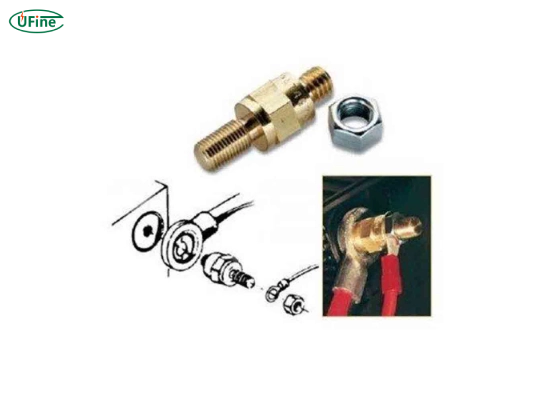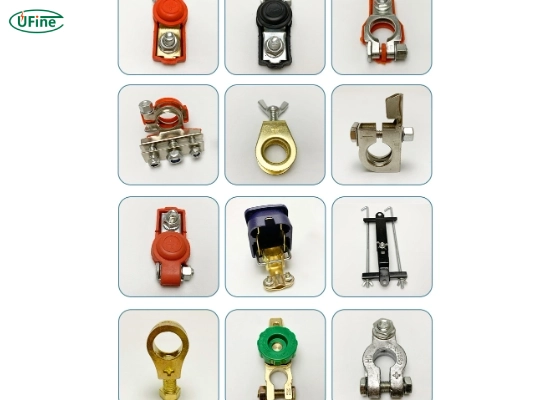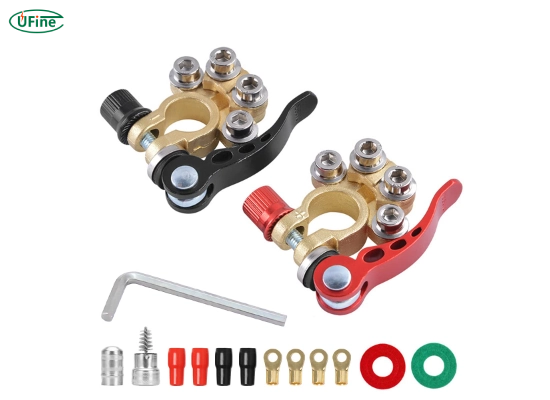Battery terminal adapters are crucial components that facilitate a secure and reliable connection between a battery and the electrical system. They come in different types, including top post, side post, and stud post adapters, each serving different applications in vehicles, marine systems, and equipment. In this guide, we’ll cover the types of battery terminal adapters, their uses, installation, and maintenance tips. Whether you’re a professional or a DIY enthusiast, this guide will provide valuable insights.
Part 1. What are battery terminal adapters?
Battery terminal adapters facilitate the connection between the battery terminals and the cables or connectors of your vehicle or equipment. They come in various shapes and sizes to accommodate different battery terminals and connectors, ensuring a reliable and secure electrical connection.
Why are battery terminal adapters essential?
Battery terminal adapters are crucial for several reasons:
- Compatibility: They allow you to use different connectors with a single battery.
- Safety: They ensure a secure connection, reducing the risk of loose connections leading to electrical failures or fires.
- Convenience: They make connecting and disconnecting the battery easier, especially in tight spaces.
Part 2. Types of battery terminal adapters: Top post, side post, stud post, and more
To understand the various types of battery terminal adapters, it’s crucial first to grasp the concept of battery terminals and how adapters relate to them.
Battery terminals are the connection points on a battery where electrical current enters or exits. They come in different styles, primarily:
- Top Post (SAE Post)
- Side Post
- Stud Post
- L-Terminal
- Button Terminal (found in some motorcycle batteries)
Battery terminal adapters are devices that modify or extend these terminals to accommodate different connection types or to improve the connection quality. They essentially bridge the gap between the battery’s native terminal and the required connection type for your specific application.
Now, let’s explore the types of battery terminal adapters in more detail:
1. Top Post (SAE Post) Adapters
These are the most common adapters, designed for batteries with standard top post terminals.
- Positive-to-Negative Converter: These adapters allow you to convert a positive post to a negative post or vice versa. This is useful when replacing a battery with a reversed polarity.
- Post Shims: These thin, conductive plates fit over the post to increase its diameter, ensuring a snug fit for oversized cable ends.
- Post-to-Stud Converters: These adapt a top post battery to accept stud-type connections.
2. Side Post Adapters
These adapters, designed for batteries with side-mounted terminals, come in several varieties.
- Side Post to Top Post Converters: These allow you to use a side post battery in a vehicle designed for top post batteries.
- Side Post Extenders provide additional connection points for accessories or multiple cables.
3. Stud Post Adapters
Use these adapters with batteries that have threaded stud terminals.
- Stud-to-Post Converters: These enable you to use stud-post batteries in applications designed for top-post batteries.
- Stud Extenders: These provide additional length to the stud for easier connection in tight spaces.
4. Marine Terminal Adapters
Specifically designed for marine environments, these adapters offer enhanced corrosion resistance.
- Wing Nut Adapters: These provide an easy-to-use connection point that you can tighten by hand.
- Multi-Port Adapters: These offer multiple connection points for various accessories that are standard in marine applications.
5. Universal Adapters
These versatile adapters work with multiple terminal types.
- Clamp-style adapters can grip various terminal types and convert them to a standard post or stud connection.
- Multi-function adapters often feature multiple connection options in one unit, allowing for great flexibility.
6. Quick Disconnect Adapters
These adapters allow for rapid connection and disconnection of the battery.
- Military-Style Quick Disconnects: Originally designed for military vehicles, these provide a secure, waterproof connection that can be quickly released.
- NATO-Style Adapters: These standardized adapters are commonly used in military and heavy-duty applications.
7. Smart Battery Terminal Adapters
A newer category of adapters that incorporate additional functionality:
- Fused Adapters include a built-in fuse for added protection against electrical faults.
- Battery Management Adapters: These may include voltage monitoring, disconnect switches, or even Bluetooth connectivity for remote monitoring.
By understanding these various battery terminal adapters, you can select the most appropriate option for your specific needs, ensuring a secure and efficient connection between your battery and electrical system. Whether you’re dealing with compatibility issues, looking to add functionality, or simply aiming to improve your existing connection, there’s likely an adapter designed for your situation.
Key Takeaways about Battery Terminal Adapters:
- Battery terminal adapters help you connect your battery to your electrical system securely.
- Types of adapters include Top Post, Side Post, Stud Post, and more.
- Selecting the right adapter depends on your battery type, application, and environment (e.g., marine or automotive).
Part 3. How do you choose the correct battery terminal adapter?
When choosing the right battery terminal adapter, consider these key factors:
- Compatibility with terminal type: Ensure it matches your battery’s terminal type (e.g., top post, side post, stud post).
- Material quality: Look for high-quality materials like brass or copper for durability and conductivity.
- Application fit: Consider whether the adapter is designed for marine, automotive, or DIY use.
Tips for buying battery terminal adapters
When buying battery terminal adapters, consider the following tips:
- Quality: Invest in high-quality adapters from durable materials like brass or copper.
- Compatibility: Ensure the adapter is compatible with your battery terminals and connectors.
- Reviews: Read reviews and ratings from other users to gauge the reliability and performance of the adapter.
- Warranty: Look for adapters that come with a guarantee for added peace of mind.
Part 4. How to install battery terminal adapters: Step-by-step guide
Installing battery terminal adapters is a straightforward process, but it requires attention to detail to ensure a secure connection:
- Disconnect the battery: Always disconnect the negative terminal first to avoid short circuits.
- Clean the terminals: Use a wire brush to remove corrosion.
- Install the adapter: Place the adapter on the terminal and secure it with the correct hardware.
- Reconnect the cables: Attach the cables to the adapter and ensure they are tight.
- Reconnect the battery: Reconnect the positive terminal first, followed by the negative terminal.
Part 5. Maintenance tips for battery terminal adapters
Proper maintenance of battery terminal adapters can extend their lifespan and ensure a reliable connection:
- Regular inspections: Check for signs of wear, corrosion, or damage.
- Clean terminals: Periodically clean adapters and terminals using a wire brush or battery cleaner.
- Ensure tight connections: Tighten connections to prevent loosening over time.
- Replace damaged adapters: Replace any worn or damaged adapters to maintain a secure connection.
What Causes Battery Terminal Corrosion?
Part 6. Common issues with battery terminal adapters and how to fix them
Battery terminal adapters can encounter several issues, but most can be easily fixed:
- Corrosion: Clean the terminals and adapters with baking soda and water to remove corrosion.
- Loose Connections: Tighten the connections to ensure a secure fit.
- Worn Adapters: Replace any worn or damaged adapters to maintain a reliable connection.
- Compatibility Issues: Ensure you use the correct adapter for your battery and connectors.
Part 7. FAQs
-
What is the purpose of a battery terminal adapter?
A battery terminal adapter facilitates the connection between the battery terminals and the cables or connectors, ensuring a secure and reliable electrical connection. -
Can I use any battery terminal adapter with my battery?
No, it would help if you chose an adapter compatible with the terminal type on your battery (top post, side post, etc.) and the connectors you use. -
How do I know if my battery terminal adapter needs to be replaced?
Signs that you need to replace your adapter include visible wear or damage, corrosion that you cannot clean, and loose connections that you cannot tighten. -
Are there specific adapters for marine batteries?
Yes, marine terminal adapters resist corrosion and suit aquatic environments. -
How often should I inspect and clean my battery terminal adapters?
You should inspect and clean your battery terminal adapters at least once every three months or more frequently if you notice any issues.
Related Tags:
More Articles

How to Choose the Best Floor Scrubber Battery for Commercial Cleaning?
Selecting the ideal floor scrubber battery ensures a long runtime, rapid charging, and minimal maintenance for efficient commercial cleaning operations.
Battery for Blower vs Battery for Leaf Vacuum: Which One Should You Choose?
Battery for blower vs leaf vacuum—learn the key differences in power, fit, and runtime to choose the right battery for your outdoor tool needs.
How to Choose the Right Battery for Blower?
Choosing the right blower battery? Consider voltage, capacity, chemistry & usage. This guide helps match the best battery for peak performance.
How to Choose the Best Insulated Battery Box for Lithium Batteries?
Choosing the Best Insulated Battery Box for Lithium Batteries? Discover key factors such as size, material, and safety for optimal protection and performance.
7 Critical Elements on a Lithium Battery Shipping Label
What must be on a lithium battery shipping label? Learn 7 key elements to ensure safety, legal compliance, and correct handling across all transport modes.






